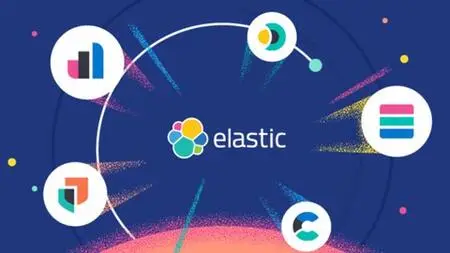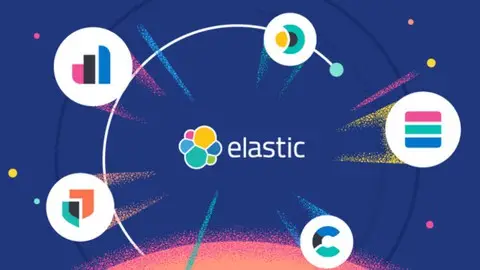Complete Elastic Stack 8 Course: Hands-On Project Included
Published 12/2023
MP4 | Video: h264, 1920x1080 | Audio: AAC, 44.1 KHz
Language: English | Size: 1.57 GB | Duration: 4h 33m
Published 12/2023
MP4 | Video: h264, 1920x1080 | Audio: AAC, 44.1 KHz
Language: English | Size: 1.57 GB | Duration: 4h 33m
A Step-by-Step Guide to Elastic Stack 8: Master Monitoring and Build a Production-Ready Cluster with a Hands On Project
What you'll learn
Master Elasticsearch fundamentals, including data indexing and modeling
Learn to configure and manage Beats, with a focus on Metricbeat
Acquire skills in Kibana for advanced data visualization and dashboard creation
Gain insights into Elastic Stack’s security mechanisms and best practices
Develop proficiency in role-based access control within the Elastic ecosystem
Understand and implement cluster monitoring techniques for Elasticsearch
Master the use of Elasticsearch's CRUD operations for effective data management
Gain hands-on experience in setting up and configuring a production-ready Elastic cluster
Learn to integrate and configure Logstash for efficient data processing and ingestion
Develop expertise in real-time infrastructure monitoring using Elastic Observability
Requirements
Operating System Knowledge: Comfort with using either Windows, Linux, or macOS, as the course may involve installation and configuration tasks
Basic Command Line Skills: Ability to use the command line or terminal for executing simple commands
Computer System: A computer with sufficient RAM (at least 8GB recommended) and processing power to install and run Elastic Stack components
A Learning Mindset: Eagerness to learn and experiment with new technologies
Description
Welcome to the "Complete Elastic Stack Bootcamp: Monitoring, Logging & Alert" course. This course serves as a comprehensive guide to mastering the Elastic Stack, a powerful suite of tools designed for real-time data searching, logging, and analytics. This course is structured to cater to both beginners and experienced professionals who seek to deepen their understanding and practical skills in Elastic Stack components.The course begins with an introduction to the Elastic Stack, providing an overview of its components and potential use cases. This foundational knowledge sets the stage for a more in-depth exploration of Elasticsearch, the heart of the Elastic Stack. Students learn about data ingestion, document indexing, and essential CRUD (Create, Read, Update, Delete) operations. Special attention is given to data modeling, mapping, and the intricacies of analyzers, tokenizers, and filters.Practical labs, such as installing and configuring Elasticsearch, are integral to the learning experience. These hands-on sessions ensure that students can apply their theoretical knowledge in real-world scenarios. The course also covers Beats, specifically Metricbeat, including its installation and configuration, accompanied by a lab and slide overviews for a comprehensive understanding.The Kibana module introduces students to this powerful data visualization tool. It includes steps for installation, basic configuration, and creating dashboards. This section is pivotal for students to learn how to visualize and analyze data effectively, illustrated through examples like visualizing VM metrics.Security in the Elastic Stack is another critical aspect covered in this course. It addresses Elasticsearch security, including practical steps to enable it and enroll Kibana with security features. Role-Based Access Control (RBAC) is explored, teaching students how to create users and assign roles, ensuring data protection and compliance.The latter part of the course delves into monitoring and observability. It provides insights into cluster monitoring, health stats, and using Metricbeat for monitoring Elasticsearch. A unique feature is the inclusion of real-time infrastructure monitoring using Elastic Observability and a hands-on project that guides students through deploying a production-ready Elastic cluster.Overall, this course offers a blend of theoretical knowledge and practical skills, making it ideal for anyone looking to master Elastic Stack for monitoring, logging, and alerting in a real-world environment.
Overview
Section 1: Introduction
Lecture 1 Overview of Elastic Stack
Lecture 2 Components of Elastic Stack
Lecture 3 Use Cases
Section 2: Elasticsearch
Lecture 4 Overview of Elasticsearch
Lecture 5 Data Ingestion and Document Indexing
Lecture 6 Basic Operations and CRUD Operations
Lecture 7 Data Modeling and Mapping
Lecture 8 Analyzers, Tokenizers, Filters
Lecture 9 Lab 1: Install and Configure Elasticsearch
Lecture 10 Lab 2: Elasticsearch Basic Operations
Section 3: Beats
Lecture 11 Overview of Beats
Lecture 12 Install Beats (Metricbeat)
Lecture 13 Metricbeat Configuration: A Slide Overview
Lecture 14 Metricbeat Configuration: Lab
Section 4: Kibana
Lecture 15 Introduction to Kibana
Lecture 16 kibana Configuration (A slide overview)
Lecture 17 Install and Access Kibana
Lecture 18 Kibana Essentials Visualizing VM Metrics - Part 1
Lecture 19 Kibana Essentials Visualizing VM Metrics - Part 2
Lecture 20 Create Kibana Dashboard
Lecture 21 Discover and Analyze
Section 5: Understand Elastic License and Trials
Lecture 22 Starts a 30-day trial
Section 6: Security
Lecture 23 Overview of Security in the Elastic Stack
Lecture 24 Enable Elasticsearch Security: (A slide overview)
Lecture 25 Enable Elasticsearch Security
Lecture 26 Enroll kibana with security enabled
Lecture 27 Securing Metricbeat for Elasticsearch Authentication
Lecture 28 Role-Based Access Control in Elastic Stack: (A slide overview)
Lecture 29 Create a User and Assign the Role
Lecture 30 Create a User for Dashboard-Only Access
Section 7: Monitoring and Observability
Lecture 31 Introduction to Cluster Monitoring
Lecture 32 Cluster Health and Stats in Elasticsearch
Lecture 33 Cluster Health Monitoring with _cluster/health endpoint
Lecture 34 Monitoring Elasticsearch with Metricbeat
Lecture 35 Monitoring Your Elasticsearch Cluster with Monitoring APIs
Lecture 36 Introduction to Elastic Stack Observability
Lecture 37 Implementing a basic observability setup
Lecture 38 Real-Time Infrastructure Monitoring with Elastic Observability
Lecture 39 Logs Stream with Elastic Observability (Nginx access log example)
Lecture 40 Install and Configure APM Server
Lecture 41 APM Python App Example
Section 8: Project: Deploy a Production-Ready Elastic Cluster
Lecture 42 Welcome to the Project
Lecture 43 Initialize First Elasticsearch Node
Lecture 44 Add Additional Master nodes to Elasticsearch cluster
Lecture 45 Add Additional Data nodes to Elasticsearch cluster
Lecture 46 Configure Master nodes roles to be master only
Lecture 47 Install and connect Kibana to project-one Elasticsearch cluster
Lecture 48 Install and Configure Logstash
Lecture 49 Configure Metricbeat to send its metrics directly to elasticsearch
Lecture 50 Configure Metricbeat to send its metrics directly to Logstash
Lecture 51 Configure alerts from Kibana - Send alerts to slack
IT Professionals: System administrators, network engineers, and IT support staff looking to enhance their monitoring and logging capabilities,Data Analysts: Professionals working with large datasets who need efficient tools for data searching, visualization, and analysis,Software Developers: Developers seeking to integrate Elastic Stack into their applications for improved data handling and analysis,DevOps Engineers: Individuals in DevOps roles aiming to implement better monitoring and observability in their workflows,Security Analysts: Cybersecurity professionals interested in leveraging Elastic Stack for security monitoring and threat analysis,Database Administrators: DBAs wanting to expand their toolkit with Elastic Stack's powerful data indexing and search capabilities,Students in Computer Science/IT: University students or learners in related fields seeking practical skills in state-of-the-art data management and analysis tools,Data Engineers: Professionals focused on building and maintaining data infrastructure, who can benefit from Elastic Stack’s robust data processing features,Business Intelligence Professionals: Those involved in BI looking to leverage Elastic Stack for real-time analytics and reporting,Tech Enthusiasts and Hobbyists: Individuals with a keen interest in data technologies and looking to acquire new skills in a leading data platform



